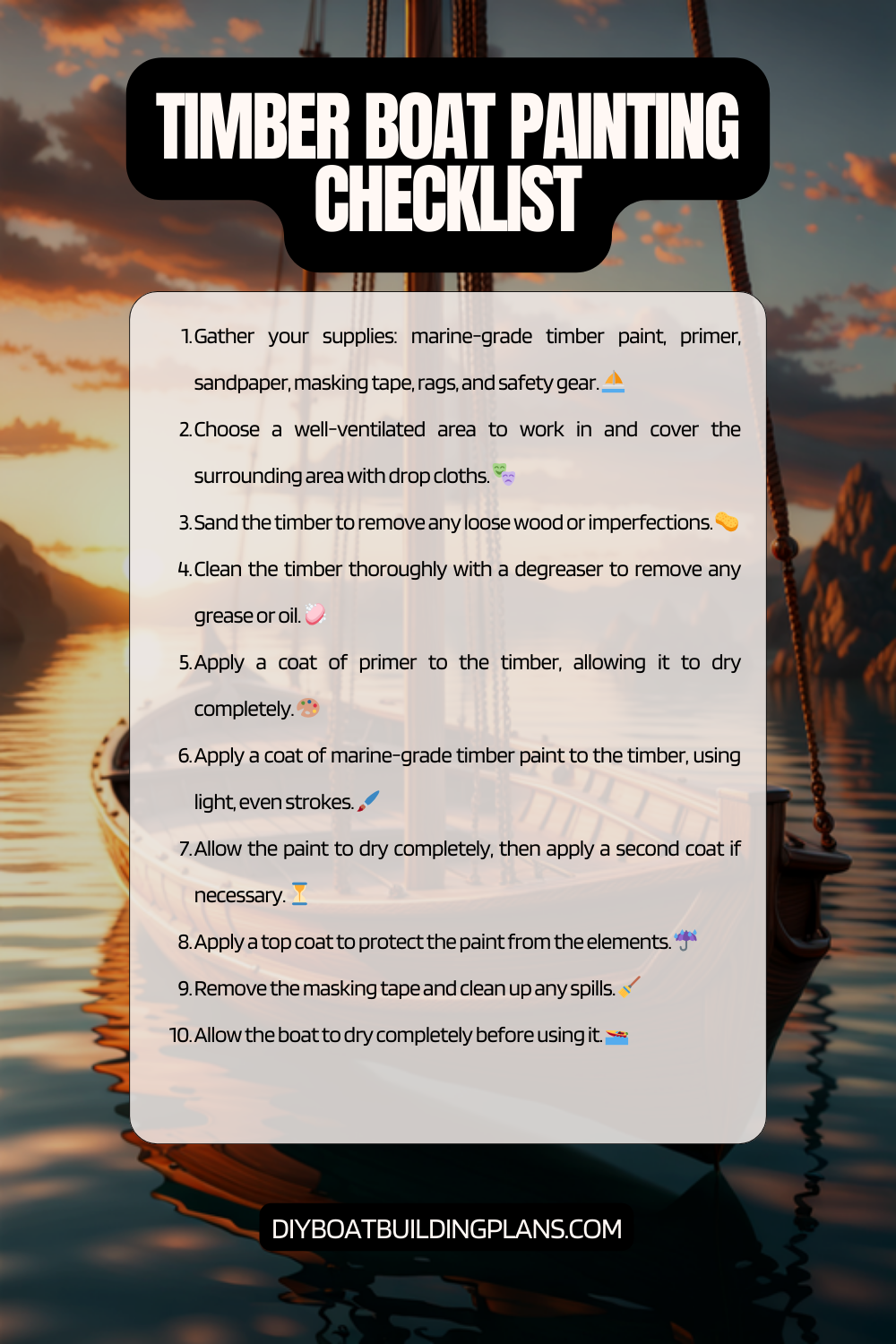Overview of Timber Boat Painting Tips
Boat painting is an essential aspect of boat maintenance that should not be overlooked. A well-painted boat not only enhances its aesthetic appeal but also protects it from the harsh elements of the water. When it comes to timber boats, special attention is required due to the unique characteristics of wood. Timber boats are susceptible to rot, decay, and damage caused by moisture, sunlight, and marine organisms. Therefore, proper painting techniques and materials are crucial to ensure the longevity and durability of a timber boat.
Key Takeaways
- Proper boat painting is important for the longevity and appearance of your timber boat.
- Choosing the right paint and preparing the boat properly are crucial steps in the process.
- Sanding techniques and applying primer are important for a smooth and even finish.
- Tips for applying paint include using thin coats and avoiding painting in direct sunlight.
- Maintaining the paint job and avoiding common mistakes can help prolong the life of your timber boat’s paint.

Importance of Proper Boat Painting
Proper boat painting offers numerous benefits that go beyond just improving the appearance of your vessel. Firstly, it provides a protective barrier against the damaging effects of water, UV rays, and saltwater corrosion. A well-painted boat is less likely to suffer from rot, decay, or structural damage caused by moisture penetration. Additionally, a good paint job can increase the resale value of your timber boat, as potential buyers are more likely to be attracted to a well-maintained and aesthetically pleasing vessel.
Neglecting boat painting can have severe consequences for your timber boat. Without proper protection, the wood can become vulnerable to rot and decay, leading to structural issues and compromising the safety of the vessel. Furthermore, exposure to UV rays can cause the wood to fade and deteriorate over time. Neglected boats are also more prone to damage from marine organisms such as barnacles and algae, which can attach themselves to the hull and impede performance. Therefore, investing time and effort into proper boat painting is essential for the longevity and performance of your timber boat.
Choosing the Right Paint for Your Timber Boat
Selecting the right paint for your timber boat is crucial for achieving a long-lasting and durable finish. Several factors should be considered when choosing paint for a timber boat. Firstly, it is important to select a paint that is specifically formulated for marine use. Marine paints are designed to withstand the harsh conditions of the water, including exposure to saltwater, UV rays, and constant moisture. Additionally, consider the type of wood used in your boat, as different types of wood may require specific types of paint or coatings.
There are various types of paint suitable for timber boats, each with its own advantages and considerations. One popular option is oil-based paint, which provides excellent durability and protection against moisture. Oil-based paints are known for their ability to penetrate the wood and create a strong bond. Another option is epoxy paint, which offers superior adhesion and resistance to water and UV rays. Epoxy paints are often used for below-the-waterline applications due to their excellent waterproofing properties. Lastly, there are also water-based paints available, which are environmentally friendly and easy to clean up. Water-based paints are a good choice for above-the-waterline applications.
Preparing Your Timber Boat for Painting
| Task | Frequency | Duration |
|---|---|---|
| Sanding | Once | 2-3 days |
| Cleaning | Before painting | 1 day |
| Priming | Once | 1-2 days |
| Painting | Once or twice | 2-3 days |
| Drying | After each coat | 24 hours |
Proper preparation is key to achieving a successful paint job on your timber boat. Before painting, it is important to thoroughly clean the boat’s surface to remove any dirt, grime, or old paint. Start by washing the boat with a mild detergent and water solution, using a soft brush or sponge to scrub away any stubborn stains or debris. Rinse the boat thoroughly with clean water and allow it to dry completely before proceeding.
Once the boat is clean and dry, it is time to inspect the surface for any signs of damage or imperfections. Repair any cracks, dents, or holes using an appropriate filler or epoxy compound. Sand down any rough areas or uneven surfaces to create a smooth and even base for painting. It is important to note that proper ventilation should be ensured during the preparation process, as some paints and fillers may emit harmful fumes.
Sanding Techniques for Timber Boat Painting
Sanding plays a crucial role in achieving a smooth and professional finish on your timber boat. There are different sanding techniques that can be employed depending on the condition of the boat’s surface. For rough or weathered surfaces, start with a coarse-grit sandpaper to remove any old paint or imperfections. Gradually progress to finer-grit sandpaper to achieve a smooth and even surface.
When sanding, it is important to follow the grain of the wood to avoid causing damage or creating uneven surfaces. Use long, even strokes and apply consistent pressure to ensure an even sanding job. It is also advisable to use a sanding block or a power sander for larger areas to achieve a more uniform finish. After sanding, make sure to remove any dust or debris from the surface before proceeding with painting.
Sanding not only helps in achieving a smooth finish but also promotes better adhesion of the paint to the wood. By creating a slightly roughened surface, the paint is able to penetrate and bond with the wood more effectively, resulting in a longer-lasting and durable paint job.
Applying Primer to Your Timber Boat
Priming is an essential step in the boat painting process, especially for timber boats. Primer acts as a protective layer between the wood and the paint, providing better adhesion and durability. It also helps to seal the wood, preventing moisture penetration and reducing the risk of rot or decay.
Before applying primer, make sure the surface is clean and dry. Use a high-quality marine-grade primer that is specifically formulated for use on timber boats. Apply the primer evenly using a brush or roller, following the manufacturer’s instructions regarding drying times and number of coats required. It is important to allow each coat of primer to dry completely before applying subsequent coats or proceeding with painting.
Priming not only enhances the durability of the paint job but also improves its appearance. By creating a smooth and even base, primer helps to minimize imperfections and create a more professional finish. It also helps to ensure that the final paint color appears true and vibrant.
Tips for Applying Paint to Your Timber Boat
When it comes to painting your timber boat, there are several tips and best practices that can help you achieve a professional finish. Firstly, make sure to choose a high-quality marine-grade paint that is specifically formulated for timber boats. Marine paints are designed to withstand the harsh conditions of the water and provide long-lasting protection.
Before applying paint, it is important to stir it thoroughly to ensure an even consistency. This helps to distribute any settling pigments or additives and ensures a uniform color throughout the paint. It is also advisable to strain the paint before application to remove any impurities or lumps that may affect the finish.
When applying paint, use a high-quality brush or roller that is suitable for the type of paint being used. Follow the manufacturer’s instructions regarding application techniques, drying times, and number of coats required. Apply thin, even coats of paint, allowing each coat to dry completely before applying the next. This helps to prevent drips, runs, or uneven coverage.
To achieve a smooth and professional finish, it is important to maintain a consistent technique throughout the painting process. Use long, even strokes and avoid overworking the paint, as this can lead to brush marks or an uneven finish. It is also advisable to work in small sections at a time, ensuring that each section is completed before moving on to the next.
Maintaining Your Timber Boat’s Paint Job
Proper maintenance is essential for preserving the longevity and appearance of your timber boat’s paint job. Regular cleaning is important to remove dirt, salt residue, and other contaminants that can accumulate on the surface. Use a mild detergent and water solution along with a soft brush or sponge to gently clean the painted surfaces. Avoid using abrasive cleaners or harsh chemicals that can damage the paint or strip away its protective properties.
Inspect the paint job regularly for any signs of damage or wear. Touch up any areas that have chipped or peeled to prevent moisture penetration and further deterioration. It is also advisable to apply a fresh coat of paint every few years to maintain the protective barrier and keep the boat looking its best.
In addition to regular cleaning and touch-ups, it is important to store your timber boat properly when not in use. Protect it from prolonged exposure to sunlight, extreme temperatures, and harsh weather conditions. Consider using a boat cover or storing the boat in a covered area to minimize the effects of the elements.
Common Mistakes to Avoid When Painting a Timber Boat
While painting a timber boat may seem straightforward, there are several common mistakes that can compromise the quality and durability of the paint job. One common mistake is neglecting proper surface preparation. Failing to clean, sand, and prime the surface adequately can result in poor adhesion, uneven coverage, and premature paint failure.
Another mistake is using low-quality or inappropriate paint for the job. It is important to choose a high-quality marine-grade paint that is specifically formulated for timber boats. Using cheap or generic paints may result in poor adhesion, color fading, or premature peeling.
Overloading the brush or roller with too much paint is another common mistake. This can lead to drips, runs, or an uneven finish. It is important to apply thin, even coats of paint and allow each coat to dry completely before applying additional coats.
Lastly, rushing the painting process is a mistake that should be avoided. Proper boat painting requires patience and attention to detail. Rushing through the process can result in sloppy workmanship, uneven coverage, or missed areas. Take your time and follow the proper techniques and steps to achieve a professional finish.
Download over 500 Boat Plans. Click on the link below.
-->Click Here<--
Professional Timber Boat Painting Services
While painting your timber boat yourself can be a rewarding experience, there are several benefits to hiring a professional timber boat painter. Professional painters have the expertise, experience, and specialized tools necessary to achieve a high-quality and long-lasting paint job.
One of the main benefits of hiring a professional is the assurance of a professional finish. Professional painters have the skills and knowledge to properly prepare the surface, choose the right paint, and apply it using the best techniques. They can achieve a smooth and even finish that is free from imperfections such as brush marks or drips.
Professional painters also have access to high-quality paints and coatings that may not be readily available to the general public. They can recommend and apply paints that are specifically formulated for timber boats, ensuring maximum durability and protection.
Additionally, hiring a professional painter can save you time and effort. Painting a timber boat can be a time-consuming and labor-intensive task, especially if you are not experienced or equipped with the necessary tools. By outsourcing the job to a professional, you can focus on other aspects of boat maintenance or simply enjoy your time on the water.
When choosing a professional timber boat painter, it is important to do your research and select a reputable and experienced company or individual. Look for references, read reviews, and ask for examples of their previous work. It is also advisable to request a detailed quote that includes all aspects of the painting process, including surface preparation, priming, painting, and any additional services such as varnishing or detailing.
Timber Boat Painting Checklist

Conclusion – Timber Boat Painting Tips
In conclusion, proper timber boat painting is essential for maintaining the appearance, performance, and longevity of your vessel. Timber boats require special attention due to their susceptibility to rot, decay, and damage caused by moisture and marine organisms. By choosing the right paint, properly preparing the surface, employing proper sanding techniques, applying primer, and following best practices for painting, you can achieve a professional finish that will protect your timber boat for years to come.
Regular maintenance and proper care are also important for preserving the paint job and ensuring its durability. Regular cleaning, touch-ups, and storage in a protected environment can help prevent damage and maintain the appearance of your timber boat.
While painting your timber boat yourself can be a rewarding experience, hiring a professional timber boat painter offers numerous benefits. Professional painters have the expertise, experience, and specialized tools necessary to achieve a high-quality and long-lasting paint job. They can save you time and effort while ensuring a professional finish.
In conclusion, proper timber boat painting is not only about aesthetics but also about protecting your investment. By following the tips and techniques outlined in this article, you can achieve a professional finish that will enhance the appearance and performance of your timber boat for years to come.
FAQs – Timber Boat Painting Tips
What is timber boat painting?
Timber boat painting is the process of applying paint or varnish to the wooden surfaces of a boat to protect it from the elements and enhance its appearance.
Why is timber boat painting important?
Timber boat painting is important because it helps to protect the wood from moisture, UV rays, and other environmental factors that can cause damage and deterioration over time. It also helps to improve the boat’s appearance and maintain its value.
What are some tips for preparing a timber boat for painting?
Some tips for preparing a timber boat for painting include cleaning the surfaces thoroughly, sanding the wood to create a smooth surface, filling any cracks or gaps with wood filler, and applying a primer to help the paint adhere properly.
What types of paint or varnish are best for timber boats?
The best types of paint or varnish for timber boats are those that are specifically designed for marine use and can withstand exposure to saltwater, sunlight, and other harsh conditions. Some popular options include two-part polyurethane paints, epoxy coatings, and marine-grade varnishes.
How should I apply paint or varnish to a timber boat?
When applying paint or varnish to a timber boat, it is important to follow the manufacturer’s instructions carefully and use the proper tools and techniques. This may include using a brush, roller, or spray gun, and applying multiple coats to ensure even coverage and maximum protection.
How often should I repaint or varnish my timber boat?
The frequency with which you need to repaint or varnish your timber boat will depend on a variety of factors, including the type of paint or varnish used, the amount of exposure to the elements, and the level of wear and tear. In general, it is recommended to repaint or varnish a timber boat every 2-3 years to maintain its appearance and protect the wood.



